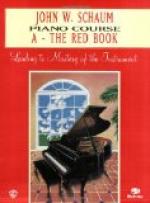THE TECHNICAL HAND
“The technical hand employs finger touch and finger action; the hand is held up, in military position, so to speak; the finger movements are quick, alert and exact; the hand is alive, not dead and heavy, as is the melody hand. The two ways of playing are quite opposite in their fundamental character, but they can be modified and blended in endless ways.
“For the technical or coloratura touch, the hand is in arched position, the five fingers are well rounded and curved, their tips are on the keys, everything is rounded. When a finger is lifted, it naturally assumes a more rounded position until it descends to the same spot on the key from which it was lifted, as though there were five little imaginary black spots on the keys, showing exactly where the finger-tips should rest. The fingers are lifted cleanly and evenly and fall on the keys—no hitting nor striking. I make a great distinction between the coloratura touch and the melody touch. The first is for rapid, brilliant passage work, sparkling, glittering, iridescent—what you will—but cold. It is made, as I said, with arched hand and raised finger action. Melody touch expresses warmth and feeling; is from the heart. Then there are the down and up arm movements, for chords, and, of course, scale and arpeggio work, with coloratura touch. I generally expect pupils who come to me to go through a short course of preparatory study with my assistant, Miss Madeleine Prosser, who has been with me for years, and does most thorough work in this line.
ASSIMILATION OF PRINCIPLES
“Many pupils come to me with no very definite ideas as to touch and what they may express through it. They think if they feel a passage sufficiently, they will be able to use the right touch for it. Sometimes they may be able to hit upon the effect they want, but they don’t know quite how they got it, nor can they repeat it another time at will. I believe the principles governing certain touches can be so thoroughly learned and assimilated that when the player sees a certain passage, he knows at once what touch is required to express it. A great actor illustrates what I mean—he knows how to employ his features and body to express the thought of his lines. When you go to the Theatre Francais in Paris, you know every member of the company is thoroughly trained in every phase of his art. You are aware that each actor has studied expression to such an extent that the features naturally fall into the required lines and curves whenever a certain emotion comes up for expression. So with the pianist—he should have the various touches at his finger-tips. The step beyond is to express himself, which he will do easily and naturally, when his has such a preparation as I have referred to.




